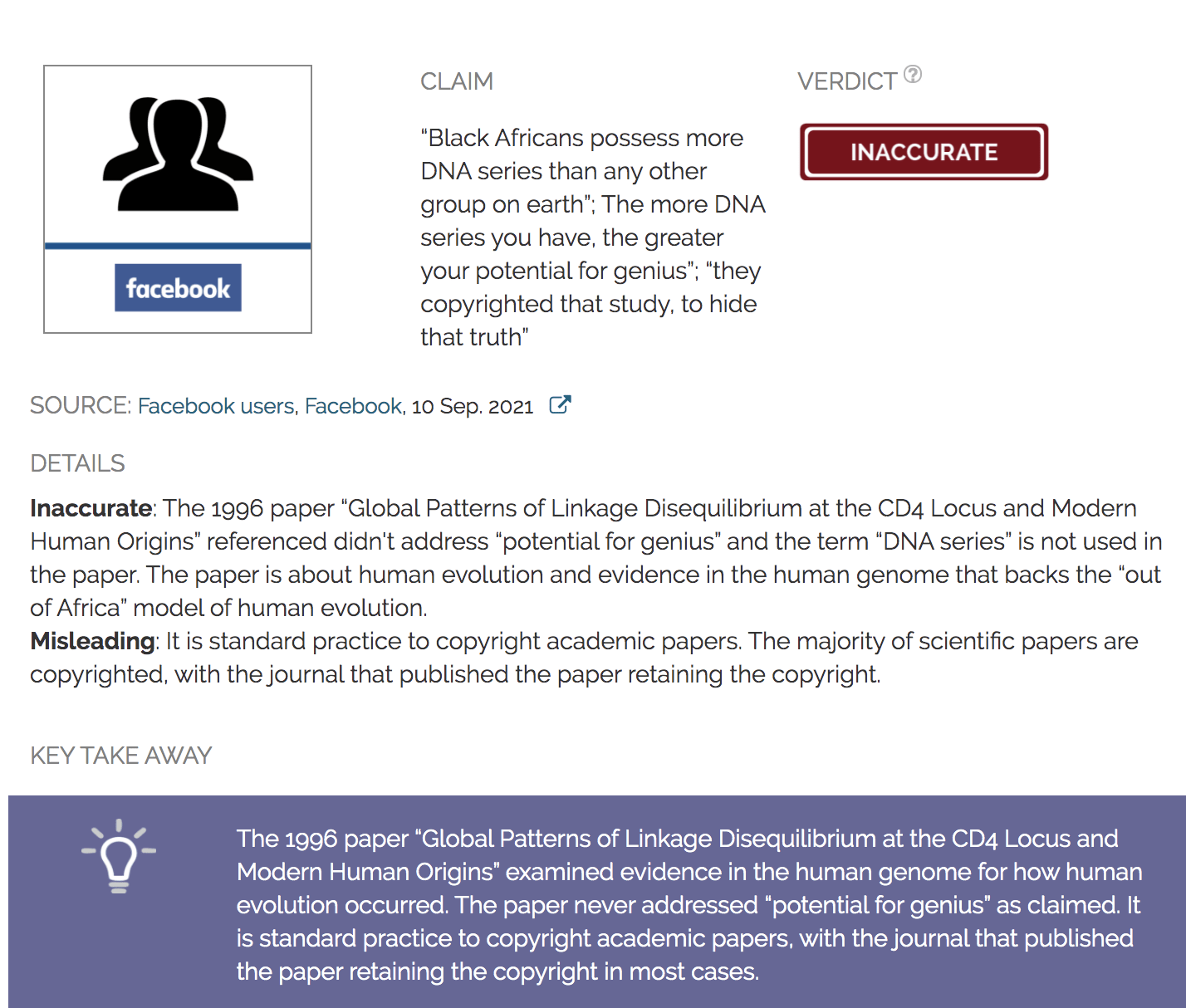- Health
1996 paper is about human evolution, not potential for genius
Key takeaway
The 1996 paper “Global Patterns of Linkage Disequilibrium at the CD4 Locus and Modern Human Origins” examined evidence in the human genome for how human evolution occurred. The paper never addressed “potential for genius” as claimed. It is standard practice to copyright academic papers, with the journal that published the paper retaining the copyright in most cases.
Reviewed content

Verdict:
Claim:
“Black Africans possess more DNA series than any other group on earth”; The more DNA series you have, the greater your potential for genius”; “they copyrighted that study, to hide that truth”
Verdict detail
Inaccurate: The 1996 paper “Global Patterns of Linkage Disequilibrium at the CD4 Locus and Modern Human Origins” referenced didn't address “potential for genius” and the term “DNA series” is not used in the paper. The paper is about human evolution and evidence in the human genome that backs the “out of Africa” model of human evolution.
Misleading: It is standard practice to copyright academic papers. The majority of scientific papers are copyrighted, with the journal that published the paper retaining the copyright.
Full Claim
“In 1996, 9 Geneticists discovered that Black Africans possessed more DNA series than any other group on earth. They have 9 DNA series while Europeans have only 6. The more DNA series you have, the greater your potential for genius. For this reason, they copyrighted that study, to hide that truth”.
Review
On 10 September 2021, Facebook users shared posts (see here and here) claiming that “in 1996, 9 geneticists discovered that Black Africans possessed more DNA series than any other group on earth”. The posts also claimed that “the more DNA series you have, the greater your potential for genius”, and that the 1996 study in which these results were published was copyrighted to hide this truth. The posts are based on a YouTube video from 29 July 2021, where an individual discussed DNA series, the potential for genius and showed a printout of the 1996 paper.
However, the 1996 paper—“Global Patterns of Linkage Disequilibrium at the CD4 Locus and Modern Human Origins”—is not about the potential for genius. Rather, the paper looks at evidence in the human genome for the “out of Africa” model of human evolution where all non-African human populations descend from a common Homo sapiens ancestor that evolved in Africa[1]. As we’ll show below, the claims made in the Facebook post are not backed up by the 1996 paper referenced.
A brief summary of the findings in the 1996 paper
In the same way we can dig up fossils and use them to help us draw the evolutionary tree of modern-day humans, geneticists can mine information in the DNA of modern humans to understand how we evolved and then spread throughout the world. Evidence from both fossils and from our own genes indicate that our species, the Homo sapiens, most likely originated in Africa before spreading across Earth; this is called the “out of Africa” model. Other models for the origin of our species have been proposed, such as the “multiregional” model (which has its proponents) where H. sapiens originated in many geographic locations multiple times.
In their 1996 paper, geneticists Sarah Tishkoff and collaborators looked for evidence for the out of Africa model in the DNA of over 1600 modern humans in 42 geographic locations[1]. They focused on the geographic distribution of two linked regions—STRP and Alu—on human chromosome 12. These two regions are considered “linked”, because they’re near each other on chromosome 12 and are often inherited together.
Both STRP and Alu have slight variations in their genetic sequences due to mutations; we call these alternative forms alleles. STRP is made up of repeated sequences of nucleotides (TTTTC), which are the building blocks of DNA; the number of repetitions varies among people, who can have anywhere from four to 15 repetitions of this nucleotide sequence. This means that there are 12 possible alleles or versions of this genetic region.
The second DNA region, Alu, has two possible alleles: one where a stretch of DNA is deleted called Alu(-), and the other where this stretch of DNA is intact called Alu(+).
Each of the 12 possible STRP alleles are linked to one of two possible Alu alleles. Because of this linkage, humans can have up to 24 possible combinations of STRP and Alu alleles. What Tishkoff and collaborators did was to look at the genomes of the more than 1600 individuals from these 42 geographically dispersed populations, and see which combinations of STRP and Alu alleles were more prevalent in these different populations.
The study found that, of these 24 possible combinations, 21 were found in the DNA of individuals from regions in Africa. In individuals from regions outside of Africa, fewer combinations of STRP and Alu alleles were found. This means that there is greater variation of STRP-Alu combinations in African populations compared to the rest of the world. The smaller diversity of STRP-Alu combinations in non-African populations compared to African populations, is evidence that humans in Asia, Europe and the Americas descend from a small group—and therefore with less STRP-Alu combination diversity—that left Africa around 100,000 years ago.
For Tischkoff and collaborators, the global distribution of these combinations “suggests a common and recent African origin for all non-African human populations” and supports the out-of-Africa model of human evolution[1].
The 1996 paper is not about “potential for genius”
Contrary to suggestions by the Facebook posts and YouTube video, the paper never addressed “the potential for genius”. The posts and video also claimed that “the more DNA series you have, the greater your potential for genius”, however the paper compared the diversity of combinations of two linked regions on chromosome 12, not the amount of DNA. Moreover, the term “DNA series” never appeared in the paper, and “DNA series” is not a term used in human evolution and genetics.
Lastly, the Facebook posts and YouTube claimed that the 1996 study was copyrighted to “hide the truth”. This is misleading because copyrighting is a standard practice in academic publishing; the majority of scientific papers are copyrighted, with the scientific journal that published the paper retaining the copyright in most cases. In this case, the owner of the copyright is most likely the journal Science, which published the paper in 1996. Currently, the paper is not open access on Science, however PDF copies of “Global Patterns of Linkage Disequilibrium at the CD4 Locus and Modern Human Origins” are available online (see here and here). In short, this study was not copyrighted to “hide the truth”, but because copyrighting papers is par for the course in traditional scientific publishing.
Conclusion
The 1996 paper by Tishkoff and collaborators “Global Patterns of Linkage Disequilibrium at the CD4 Locus and Modern Human Origins” sought evidence in the human genome for the “out of Africa” model of human evolution. But the paper never addressed “potential for genius” or “DNA series”, as claimed in recent Facebook posts.
References
- 1 – Tishkoff et al. (1996) Global patterns of linkage disequilibrium at the CD4 locus and modern human origins. Science

